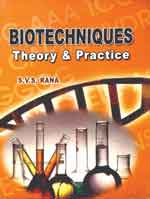|
बी एस-सी - एम एस-सी >> बायोटेक्निक्स - थ्योरी और प्रैक्टिस बायोटेक्निक्स - थ्योरी और प्रैक्टिसप्रो. एस वी एस राणा
|
5 पाठक हैं |
||||||
स्नातक एवं परास्नातक पाठ्यक्रनानुसार पाठ्य पुस्तक
|
|||||
स्नातक एवं परास्नातक पाठ्यक्रनानुसार पाठ्य पुस्तक
स्नातक एवं परास्नातक पाठ्यक्रनानुसार पाठ्य पुस्तक
A Text-Book For University Students
Contents
1. Assay Methods ... 1-7
Selection of a Valid Method; Bioassay: Reliability of Data: UNITS, CONVERSION AND ABBREVIATIONS Metric and English Units.
2. Cell and Tissue Culture ... 8-29
Microbial Cell Culture; Culture Media: Plant Cell and Tisstre Culture: Animal Cell Culture; Organ Culture: Synthetic Medium: Growth Media for Mammalian Cell Culture: Most Commonly Used Media and Solutions for Bacteria; Ames Test: Principle and Tester Strains; Specific Techniques: Metabolizing System: Rat Liver S9 Mix: Future Prospects; Flow Cytometry : Advantages of Flow Cytometry: Stains. FCM in Microbiology
3. Basic Requirements in a Biological Laboratory ... 30-40
Instruments and Appliances: Tocols; Glassware; Miscellaneous
4. Fixation ... 41-55
Coagulants: Non-Coagulunts: Chemistry of Fixation: Chemical Actions of Vapour Fixatives Practical Fixative Solutions; Freeze-Drying: Cryopreservation
5. Histological Methods ... 56–71
Fixation; Dehydration; Clearing; Embedding; Microtomy; Staining; Stains; Uses of Stains: Classification of Stains: Mechanism of Staining; Cytochemical Stains: Chemistry of Staining: Interpreting Sections - Helpful Hints; Artifacts.
6. Microscopy ... 72-96
Light Microscopy: Phase Contrast Interference Microscopy: Interference Microscopy: UltraMicroscopy: Polarization Microscopy: Fluorescence Microscopy; Electron Microscopy; Confocal Microscopy : Atomic Force Microscopy: Cryoelectron Microscopy: Image Analysis and Video Microscopy: Telemicroscopy: Optical Characterization and Imaging of Biological Tissues; Advantages and Disadvantages of Three Types of Microscopy: Sample Preparation; Freeze-fracture Electron Microscopy.
7. Centrifugation ... 97-105
Principle of Centrifugation; Types of Analytical Centrifugation; Applications of Centrifuges: Precautions.
8. Spectrophotometry ... 106-140
Beer-Lambert Relationship: Instrumentation: Applications of Spectrophotometry: Atomic Spectroscopy: Flaine Emission Photometry; Atomic Absorption Spectrophotometry: Spectrofluorimetry; Luminometry; Infrared Spectroscopy: Qualitative Uses and Interpretation of Spectra; Instrument Considerations; Fourier Transform IR Spectrometers; Applications of Infrared Spectroscopy: Analysis of Stroke-Induced Changes by Near-Infrared Spectroscopy: Applications in Toxicological Studies; Specialized Instrumentation: Raman Spectroscopy: Surface Plasmon Resonance (SPR) Spectroscopy.
9. Mass Spectrometry ... 141-147
Simplified Schematic of a Mass Spectrometer; Matrix Assisted Laser Desorption Ionization (MALDI): Simplified Schematic of MALDI-TOF Mass Spectrometry (Linear Mode) (TofSpec); Positive or Negative Ionization; Detection and Recording of Sample lons; Tandem Mass Spectrometry: Uses of Mass Spectrometry.
10. Electron Spin Resonance and Nuclear Magnetic Resonance Spectroscopy ... 148-159
Electron Spin Resonance and Spin-trapping : Instrumentation; Applications; Nuclear Magnetic Resonance Spectroscopy; Instrumentation; Applications.
11. X-Ray Diffraction ... 160-166
Fiber Diffraction; Crystal Diffraction; Instrument: Applications.
12. Chromatography ... 167-180
Liquid Solid Chromatography (Adsorption Chromatography): Liquid-liquid Chromatography: Paper Chromatography: High Performance Liquid Chromatography (HPLC); Gas-Liquid Chromatography (GLC); Chromatofocusing: Affinity Chromatography.
13. Electrophoresis ... 181-190
Instrumentation.
14. Polymerase Chain Reaction (PCR) ... 191-198
Principle and Working Mechanism; Constraints in PCR: Practical Modifications of the PCR Technique: Recent Developments in PCR Techniques: Applications.
15. Immunodiagnostic Methods ... 199-218
Antibodies: Inmunoassay: Immunoprecipitation; Radioimmunoassay (RIA): Homogeneous Assay (EMIT); Immunofluorescence Techniques: Immunocytochemistry.
16. Radio-isotopes Techniques ... 219--231
Nature of Radioactivity: Types of Radioactivity: Methods for Detection and Measurement of Radioactivity: Autoradiography and its Applications; IP Autoradiography System (IPAS).
17. Electrochemical Techniques & Biosensors ... 232-244
Principles of Electrochemical Techniques: Classification of Electrochemical Techniques; Potentiometry: lon-sclective Electrodes; Conductimetry; Coulometric Analysis; Biosensors.
18. Methods of Environmental Analysis ... 245–253
Methods for Quantitative Analysis: Gravimetric Method: Volumetric Methods: Ultraviolet and Visible Spectrophotometry; Infrared and Ram Spectroscopy: Light Scattering Techniques: Molecular Luminescence Methods: Atoinic Absorption Spectroscopy (AAS): Atomic Emission Spectroscopy: Radio Analytical Methods: Electro Analytical Techniques: Ring-oven Technique; Separation Methods.
19. Air Pollution Analysis ... 254–266
Introduction: Sampling of Gaseous Pollutants: Analysis of Aerosols: Analysis of Gaseous Pollutants: Sulphur dioxide Analysis; H2S Analysis: NO-NOx Analysis; CO-CO. Analysis: Ozone Analysis: NH3-Analysis; Organic Gases and Vapour Analysis.
20. Monitoring of Ambient Air Pollution ... 267-274
Air Pollution Monitoring Instruments: Meteorological Instruments: Monitoring of Sulphur Dioxide; Monitoring of NO-NO2: Monitoring of CO, CO2. Monitoring of Hydrocarbons (HC) and Ozone; Monitoring of Suspended Particulate Matter.
21. Water Pollution Analysis ... 275-285
Physical Examination of Water: Chemical Characterisation of Water; Biological Investigation of Water: Biological Water Quality Assessment, Importance, Objectives and Scope: Biological Water Quality Criteria (BWQC); Benthic Macro-Invertebrates Taxa: Steps Involved for Bio-Monitoring of Surface Water Bodies in Problem Areas in the Country.
22. Soil Pollution and Pesticide Analysis ... 286-291
Role of Micronutrients in Soil; Analysis of Micronutrients in Soil; Trace Elements Analysis in Soil; Pesticides and Pollution; Pesticide Analysis; Chromatographic Characterisation of Pesticides: Polarographic Analysis of Pesticides; Spectroscopic Analysis of Pesticides.
23. Noise Pollution Measurement ... 292-294
What is Noise?; Noise Measurement; Noise Mapping; Anechoic Chamber; Environment and Noise Measurements.
24. Applications of Computer in Modern Biology ... 295-306
Bioinformatics; Genomics; Genome Mapping: Gene Cloning: Gene Sequencing with Dideoxynucleotides: Proteomics.
25. Perfusion, Organ Ablations / Surgical Techniques ... 307-318
Perfusion Techniques: Overiectomy in Rodent; Orchidectomy in Rodent: Adrenalectomy in Rodent ; Thyroidectomy in Rat: Parathyroidectomy in Pigeon: Parabiosis in Rat.
26. Management of Laboratory Animals ... 319-330
Laboratory Animal: Animal Procurement; Quarantine, Stabilization and Separation: Surveillance. Diagnosis, Treatment; and Control of Discase; Animal Care and Technical Personnel: Personal Hygiene: Animal Experimentation Involving Hazardous Agents; Duration of Experiments; Physical Plan; Environment; Animal Husbandry: Personnal and Training; Laboratory Aniinal Ethics.
27. Biostatistics ... 331-342
Sampling and Sampling Methods; Sampling and Sampling Designs; Selection of Appropriate Method of Sampling: Measures of Central Tendency: Median: Median for Group Data: Mode: Measures of Dispersion or Spread; Range; Mean Deviation: Standard Deviation; Variance; Standard Error of the Mean (SEM); Coefficient of Variation; Tests of Significance.
28. Preparation of Reagents, Stains and Buffers ... 343-351
Molar Solution: Normal Solation: Chemical Fixatives; Stains; Other Useful Reagents; Mounting Media: Preparation of Buffers: Andre's Mounting Medium: Gary's Magic Mountant; Gelatin/Glycerol Mountant; Mayer's Albumin; Methacrylate: Mollenhauer's Mixture No. 2 ; Mountants, Nonaqueous..
29. Hazardous Laboratory Materials/Chemicals ... 352-359
Suggested Further Readings ... 361-364
|
|||||














